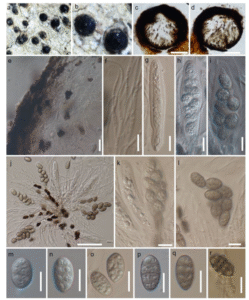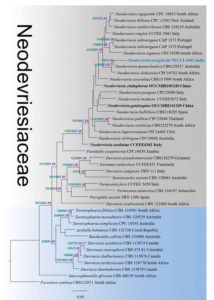Neodevriesia manglicola Devadatha, V.V. Sarma & E.B.G. Jones, sp. nov.
Index Fungorum number: IF 556225; MycoBank number: MB 556225; Facesoffungi number: FoF 07057; Fig. 1
Etymology – In reference to the mangrove habitat where the fungus was collected.
Holotype – AMH-10019.
Saprobic on decaying wood of Rhizophora mucronata. Ascomata 250–350 µm high, 200–500 µm wide (x̅ = 285 × 297 µm, n = 20), globose or subglobose, superficial to semi-immersed, carbonaceous, short papillate and ostiolate. Ostiole 45–100 µm long, 50–60 µm diam (x̅ = 74 × 55 µm, n = 5), periphysate. Peridium two layered, 30–70 µm (x̅ = 51 µm, n = 5), thickened, outer layer of small pseudoparenchymatous cells, brown, inner layer of hyaline polygonal cells. Hamathecium composed of cellular, hyphallike, septate pseudoparaphyses. Asci 60–100 × 15–25 µm (x̅ = 76 × 18 µm, n = 15), 8-spored, bitunicate, thick-walled, clavate to cylindrical, short pedicellate, apically rounded. Ascospores 8–17 × 3–10 µm (x̅ = 14 × 8 µm, n = 25), overlapping uniseriate, ellipsoid, hyaline to dark brown, muriformed appearance due to longitudinal pseudosepta with oil globules, 0–3-transverse septa and 1 longitudinal septum in each cell, fully matured ascospores becoming brown with 3 dark brown banded septa, lacking mucilaginous sheaths or appendages.
Material examined – INDIA, Tamil Nadu, Parangipettai mangroves (11.59°N, 79.5°E), on decaying wood of Rhizophora mucronata (Rhizophoraceae), 23 April 2018, B. Devadatha, AMH-10019 (holotype), living culture, NFCCI-4382.
GenBank numbers – ITS: MN061371; LSU: MN061356.
Culture characteristics – Ascospores germinating on 50% sea water agar within 24 h, with germ tubes developed from both end cells and sides of ascospores. Colonies on MEA slow growing, reaching 10–20 mm diam, after 15 days of incubation at 25 °C, surface pale brown to dark brown on the surface, reverse brown, velvety, irregular and umbonate.
Notes – Our phylogeny of LSU and ITS sequences including taxa from Neodevriesia, Devriesia and other related genera revealed that N. manglicola is sister to N. queens landica with significant support (ML 78% and 1.00 PP), and then nested with N. shakazului in a monophyletic clade with strong support (ML 100%, MP 99% and 1.00 PP) (Fig. 2). Recently two new species, N. cladophorae and N. grateloupiae, were reported from marine environments (Wang et al. 2017). These two species are phylogenetically nested distant to N. manglicola, and are known to produce only asexual morphs. N. manglicola is the first report of a species having a sexual morph in the genus though it remained nonsporulating in artifical media. We introduce N. manglicola as a new species in Neodevriesia

Figure – Neodevriesia manglicola (AMH-10019, holotype). a–b Ascomata superficial to semi-immersed on decaying wood. c–d Vertical sections of ascomata. e Peridium. f Filamentous pseudoparaphyses. g–l Immature and mature asci. m–q Immature and mature ascospores. r Germinating ascospores. Scale bars: c–d = 100 μm, e–i = 10 μm, j = 50 μm, k–r = 10 μm

Figure – Phylogram generated from maximum parsimony analysis based on LSU and ITS gene regions. Bootstrap support values for maximum likelihood (ML, green), maximum parsimony (MP, blue) ≥ 70% and the values of Bayesian posterior probabilities (PP, purple) ≥ 0.95 are given above each branch, respectively. The new isolate is in blue. The tree is rooted with Passalora zambiae CBS112971
